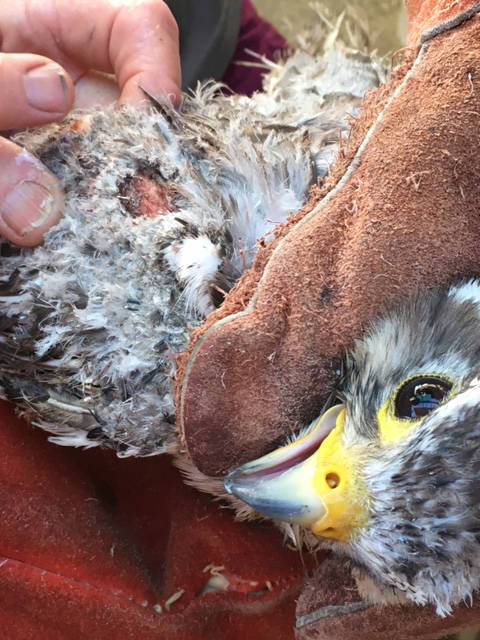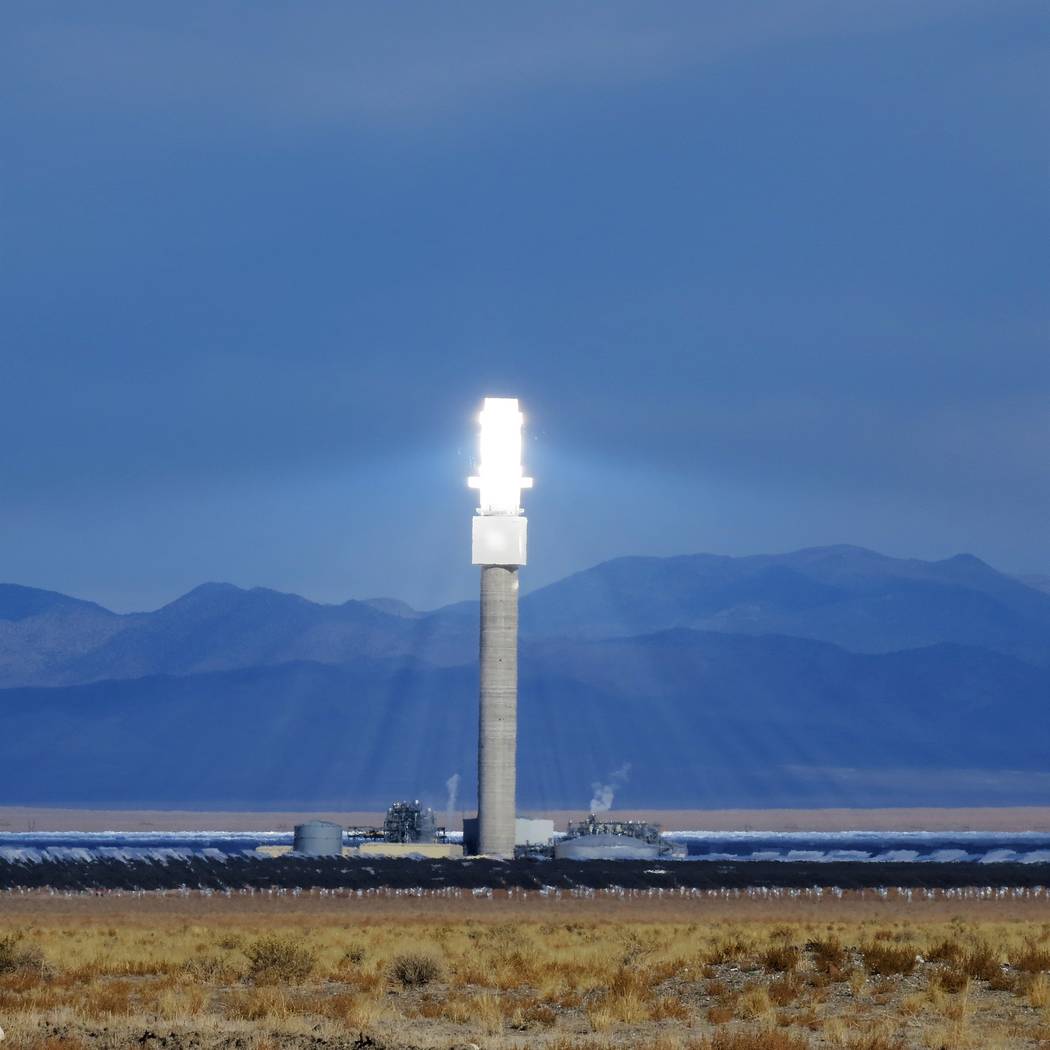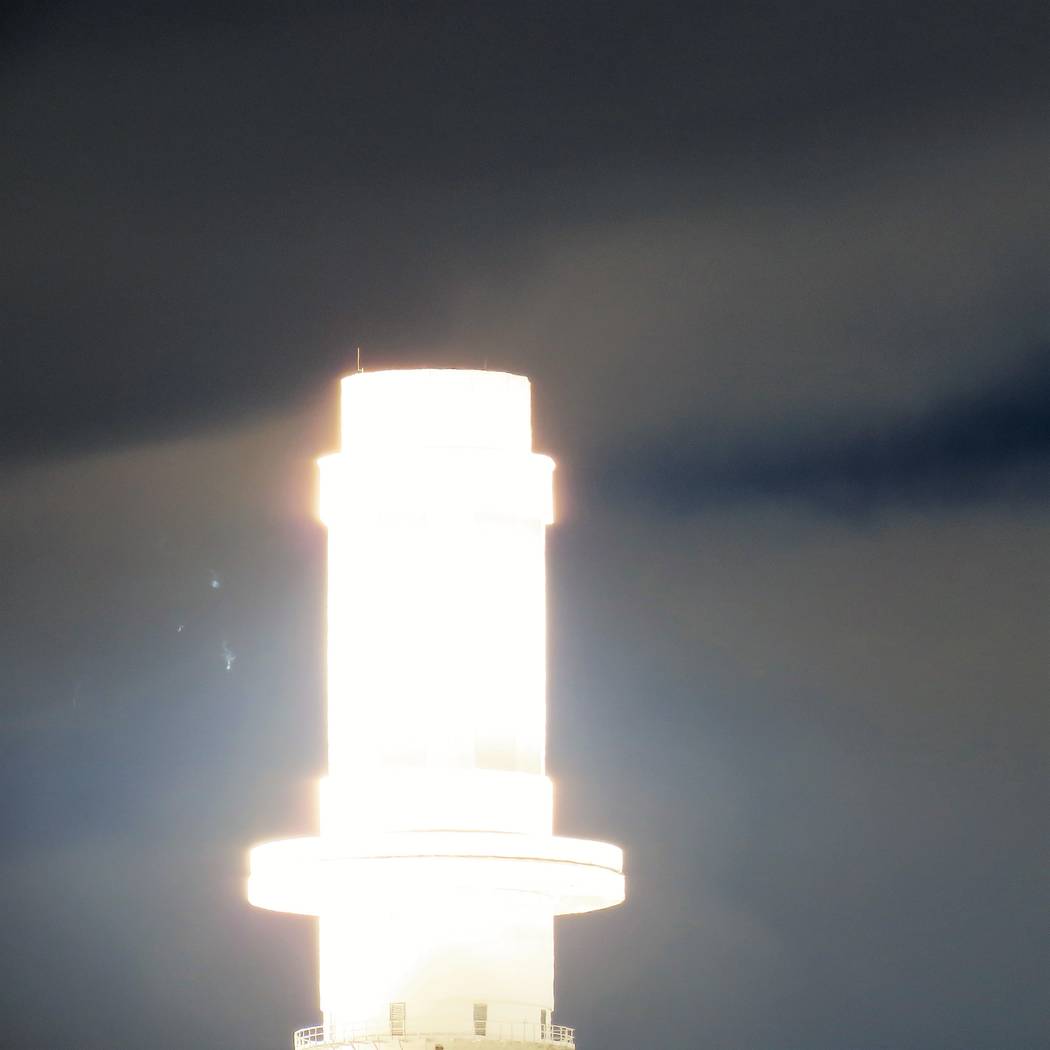Glare from proposed Nye solar project raises concerns
An environmental group is concerned about a potential glare from up to 10 proposed solar towers in Nye County.
Kevin Emmerich, a co-founder of Basin and Range Watch, a Beatty-based nonprofit that strives to conserve the deserts in Nevada and California, said a Sandstone project could run into issues because of the glare that the military may face from the proposed eight to 10 towers near Tonopah.
“The blinding glare created from the three large arrays of heliostats (reflector mirrors) at the similar Ivanpah Solar Project near Primm, Nevada has created well-documented visual obstructions for commercial pilots flying over the project, Emmerich said in an email. “It seems only logical that ten new towers in a military flight zone would create issues for Nellis pilots.”
Sandstone, proposed by Santa Monica, California-based Solar Reserve, would be located on 20,000 acres of U.S. Bureau of Land Management property north of the Crescent Dunes Solar Energy Project.
Under a proposed scenario, the project would be built in the vicinity of a military flight corridor between the Fallon Range Training Complex to the north, and the Nellis Test and Training Range to the south.
SolarReserve built Crescent Dunes in the same area, but the project has only one tower and mirror field, which is much smaller than the proposed Sandstone project, which could add 25 square miles of mirrors along the military flight zone.
According to the Sandia National Laboratories’ 2014 study of the Ivanpah Solar Electric Generating System in California, the glint and glare emanating from mirrors associated with solar power tower projects can cause temporary vision impairment, otherwise called after-images, for people within six miles of the project.
The impact radius from Sandstone would affect nearly the entire width of the military flight corridor, and could potentially affect military training operations.
Reports of glare from Ivanpah near Primm have been submitted by pilots and air traffic controllers and recorded by the Aviation Safety Reporting System and the California Energy Commission since 2013, the study said.
Evaluation of the glare from Ivanpah showed that the retinal irradiance and subtended source angle of the glare from the heliostats in standby were sufficient to cause significant ocular impact up to a distance of six miles, but the values were below the threshold for permanent eye damage.
Glare from the receivers had a low potential for after-image at all ground-based monitoring locations outside of the site boundaries, the study said.
Sue Holmes, Sandia’s spokeswoman, said no similar study has been conducted for Crescent Dunes or the proposed Sandstone project.
“The principles from the Ivanpah study are applicable and the general information is useful, although the circumstances and actual geometry of each solar field differs,” Holmes said.
FOIA’s request
Sandstone Solar Energy, a subsidiary of SolarReserve, submitted a right-of-way application to the Bureau of Land Management Tonopah Field Office in August. The document was obtained by Basin and Range through the Freedom of Information Act.
According to the application, the company performed a preliminary screening of BLM land in the vicinity of the proposed project before selecting the portion of land reflected in the application.
Sandstone Solar Energy evaluated land proximate to Silver Peak in Esmeralda County, along with land in the vicinity of Millers Solar Energy Zone as well as an expanse of land spanning both north and south of the existing Crescent Dunes Solar Energy Project, before zeroing in on a proposed site.
“Many considerations were involved in this land-screening process, and ultimately the site was selected because it represents what we believe is optimal land utilization with the lowest negative impacts,” according to the documents.
The two out of 10 plants which are not subject to the application are envisioned to be located within the Millers Solar Energy Zone boundaries and will be subject to a separate application at a later date, Sandstone officials said.
Project’s characteristics
Sandstone’s application to the BLM meanwhile doesn’t call for a significant visual impact.
“Although the project poses a potential for visual impacts, such as the receiver towers, current visual quality is low due to lack of distinctive visual features. Overall visual change is expected to be moderate,” Sandstone officials said in the application.
The size of each solar field will be approximately 2,000 acres with heliostat mirrors arranged in a circular field around the tower. Each tower could be approximately 920 feet in height - higher than the current tower at Crescent Dunes.
Officials said Sandstone Solar Energy’s technology requires a large open space of approximately four square miles of contiguous land, with minimal slope or topographical undulations, nearby transmission access, access to roads and infrastructure, as well as water availability.
“Ultimately, Sandstone Solar Energy selected the proposed site because it represented the land with the highest value and the smallest impacts on the existing resources,” Sandstone officials said.
The total cost of each plant is estimated to be $500 million, for a combined capital cost of approximately $4 billion for eight towers.
“If built in another location, the project would not be able to benefit from the economies of scale resulting from construction of up to 10 plants,” Sandstone said.
Mary Grikas, spokeswoman for SolarReserve, said the Sandstone project development is “progressing as planned,” but is not expected to start construction for two to three years.
Wildlife concerns
Basin and Range also said they are concerned about a potential increase in bird mortality, should 10 more towers be built near Tonopah.
“We are very concerned that if eight or 10 more of these towers are built in Big Smoky Valley, the bird mortality incidents will be much more frequent,” Emmerich said.
Photos taken by Basin and Range on Monday show birds vaporizing in the energy of solar flux at the Crescent Dunes Solar Energy Project near Tonopah.
Emmerich said the nonprofit plans to take action, should Sandstone move forward.
“We do plan on following the BLM process and oppose the project through the Bureau of Land Management and Nevada Public Utilities Commission,” Emmerich said.
Contact reporter Daria Sokolova at dsokolova@pvtimes.com. On Twitter: @dariasokolova77






















